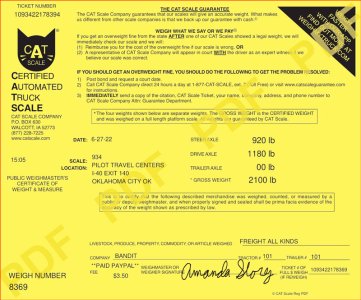AltBantam
Active Member
I'm sure many of you already know this method, but those who don't, new to building a car, here is an inexpensive way to weight your bucket for coilovers or just general discussion among fellow car fanatics. Auto scales started at around $800 from what I could find when I wanted to weigh my "altered" 32' Bantam. But many people have used bathroom scales for much less and get the same results. I started by looking on Amazon. I bought the cheapest 400 lb bathroom scales I could find. You want 400 lbs. No reason to buy 300 lb scales only to realized there's not enough scale there to measure the weight of your car. Normally $12 plus, the scales I bought were on sell for $9.99. You will need 8 minimum. For something other than a t bucket, you might need 10 or 12 bathroom scales. I bought 8 for $80, Prime shipping in two days for free. You next need a board. The board will lay atop 2 scales which will be placed underneath each wheel. I had an 8 foot 2 x 4 laying around. Cut it into 4- 2 foot lengths. My tires sat fine on a 2 x 4. You may use a 2 x 6 or larger if you wish. You will want to weight each board to subtract that weight from that side's measurements. Next, jack up the front and rearend to move scales and boards under the tires. I lifted off the center of the straight axle in the front and the center of the 9" housing in the rear. You need to set up your scales on all 4 corners before you begin. If you want to be cheap and buy just two scales, you will still need to block the tires on the other 3 corners to the same height as the tire with the scales, otherwise you will get a false reading due to the scaled tire sitting higher than the other 3 tires. I set the from up then moved to the rear. I did not have problems with the car rolling as I jacked it up, but if you do, add a chock to the front or rear tires to keep them from moving. Before you set the tires on the boards sitting atop the scales, make sure your scales are centered with the tire. That way the weight shown on the scales should be more evenly distributed. The scales are going to start measuring the weight as you sit the tires down. That's okay. Once everything is good, jack up the part of the car where the jack still is. For me, the rear. Then lower. If you are alone, move quickly. If you someone helping you, have them take one side and you the other. The weights, once finalized, normally clears after 3 to 5 seconds, depending on the scales. It took me two tries raising and lowering the rearend on the rear of the car my first time because I moved too slow. Write down the two weights from both scales per side. Once you have those 4 numbers, move to the opposite end of the car, for me the front. Jack up the front then set it back down on the scales. Write down the two weights from both scales per side. Finish by adding each side together. That number is the current weight on that tire. Now, the $800 plus scale might have an error factor of less than 1%. Even if the bathroom scales error is above 1%, your numbers will get you within the ballpark. My first weigh-in on my Bantam with a big block Buick, 3 speed Dearborn manual transmission, 9" rear with disc brakes, wooded and glassed body with seats, 1461 lbs. 751 lbs. at the rear and 710 lbs. on the front. My rear will use coilover shocks. Once the car is ready for the street, I will reweight the rear and calculate what spring rate I will need. You don't need to pay out big $$$ to weigh your car. Just use bathroom scales instead. Good luck.





